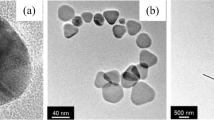Abstract
A small- and wide-angle X-ray scattering (SWAXS) technique using a laboratory X-ray source is reported in this article. This non-destructive SWAXS technique allows simultaneous measurements of the primary particle or pore size, surface and mass-fractal dimensions, as well as quantitative determination of the crystallite properties, like phase identification, the co-existence of crystallite components, and their fractions. Some selected experimental results of the SWAXS study of the metallic and oxide nanostructured particles (such as pure Silver nanoparticles, commercial AEROXIDE® TiO2 P25, Nickel and Nickel oxide nanoparticles as well as Titanium nanoparticles generated by a laboratory electric discharge generator) are presented and discussed in detail, covering a size range of 1–50 nm. The results obtained by SWAXS are compared to those observed with the transmission electron microscope and scanning electron microscope, as well as the XRD reference patterns from the RRUFF database, showing good agreement. In addition, a comparison between powder and dispersion measurements was carried out for estimating the existence and accessibility of microporous structures inside the synthesized nanoparticles, as well as the fraction of open pores. Because of many advantages, such as the high intensity of the primary beam while using a conventional laboratory X-ray source equipped with unique X-ray focusing optics, a short measurement time can be realized. By noninvasive simultaneous measurement of SAXS and WAXS spectra using a single detector; this unique technique allows for fast and extensive in-situ characterizations of metal and metal oxide nanoparticles, respectively, as well as nanostructured materials in many other potential application fields.






Similar content being viewed by others
References
Beaucage G (1995) Approximations leading to a unified exponential/power-law approach to small-angle scattering. J Appl Crystallogr 28:717–728
Beaucage G (1996) Small-angle scattering from polymeric mass fractals of arbitrary mass-fractal dimension. J Appl Crystallogr 29:134–146
Beaucage G (2004) Determination of branch fraction and minimum dimension of mass-fractal aggregates. Phys Rev E 70:031401
Beaucage G, Kammler HK, Pratsinis SE (2004) Particle size distributions from small-angle scattering using global scattering functions. J Appl Crystallogr 37:523–535
Bergmann A, Orthaber D, Scherf G, Glatter O (2000) Improvement of SAXS measurements on Kratky slit systems by Göbel mirrors and imaging-plate detectors. J Appl Crystallogr 33:869–875
Dingenouts N (1999) Röntgenkleinwinkelstreuung als Methodik der Strukturanalyse teilgeordneter kolloidaler Systeme. Dissertation, Universität Karlsruhe, Germany
Dingenouts N, Ballauff M (1998) Structural investigation of latexes by small-angle X ray scattering in slit-collimation: measurements and evaluation of data. Acta Polym 49:178–183
Downs R T (2006) The RRUFF project: an integrated study of the chemistry, crystallography, Raman and infrared spectroscopy of minerals. Program and abstracts of the 19th general meeting of the international mineralogical association in Kobe, Japan, O03-13. http://rruff.info/index.php
Fairen-Jimenez D, Carrasco-Marin F, Djurado D, Bley F, Ehrburger-Dolle F, Moreno-Castilla C (2006) Surface area and microporosity of carbon aerogels from gas adsorption and small- and wide-angle X-ray scattering measurements. J Phys Chem B 110:8681–8688
Goertz V (2011) Untersuchungen zur Synthese und zum Wachstum von anorganischen Nanopartikeln in der Flüssig- und Gasphase mit Hilfe der Röntgenkleinwinkelstreuung. Dissertation, Karlsruhe Institute of Technology, Germany
Goertz V, Dingenouts N, Nirschl H (2009) Comparison of nanometric particle size distributions as determined by SAXS, TEM and analytical ultracentrifuge. Part Part Syst Charact 26:17–24
Guinier A, Fournet G (1955) Small angle scattering of X rays. Wiley, New York
Hashimoto K, Irie H, Fujishima A (2005) TiO2 photocatalysis: a historical overview and future prospects. Jpn J Appl Phys 44(12):8269–8285
Klug HP, Alexander LE (1954) X-ray diffraction procedures for polycrystalline and amorphous materials. Wiley, London
Kratky O, Glatter O (1982) Small angle X-ray scattering. Academic Press, London
Kruis FE, Fissan H, Peled A (1998) Synthesis of nanoparticles in the gas phase for electronic, optical and magnetic applications—a review. J Aerosol Sci 29(5/6):511–535
Linsinger T, Roebben G, Gilliland D, Calzolai L, Rossi F, Gibson N, Klein C (2012) Requirements on measurements for the implementation of the European Commission definition of the term “nanomaterial”. JRC Reference Reports 2012, European Commission EUR25404-Joint Research Centre-Institute for Reference Materials and Measurements, ISSN 1831-9424 (online). doi:10.2787/63490
Schmidt PW (1991) Small-angle scattering studies of disordered, porous and fractal systems. J Appl Crystallogr 24:414–435
Schwyn S, Garwin E, Schmidt-Ott A (1988) Aerosol generation by spark discharge. J Aerosol Sci 19(5):639–642
Spurr RA, Myers H (1957) Quantitative analysis of anatase–rutile mixtures with an X-ray diffractometer. Anal Chem 29(5):760–762
Tabrizi NS (2009) Generation of nanoparticles by spark discharge. Dissertation, Delft University of Technology, the Netherlands
Tabrizi NS, Xu Q, Van der Pers M, Lafont U, Schmidt-Ott A (2009) Synthesis of mixed metallic nanoparticles by spark discharge. J Nanopart Res 11(5):1209–1218
Tabrizi NS, Xu Q, Van der Pers N, Schmidt-Ott A (2010) Generation of mixed metallic nanoparticles from immiscible metals by spark discharge. J Nanopart Res 12(1):247–259
Vons VA, Smet LCPM, Munao D, Evirgen A, Kelder EM, Schmidt-Ott A (2011a) Silicon nanoparticles produced by spark discharge. J Nanopart Res 13:4867–4879
Vons VA, Anastasopol A, Legerstee WJ, Mulder FM, Eijt SWH, Schmidt-Ott A (2011b) Low-temperature hydrogen desorption and the structural properties of spark discharge generated Mg nanoparticles. Acta Mater 59:3070–3080
Acknowledgments
The research leading to these results has received funding from the European Union’s Seventh Framework Programme under Grant Agreement No. 280765 (BUONAPART-E). We also acknowledge the support from the German Research Foundation (DFG Ni 414/13-1). We express our immense thanks to Mr. Thomas Lebe for the experimental assistance with TEM and SEM.
Author information
Authors and Affiliations
Corresponding author
Rights and permissions
About this article
Cite this article
Guo, X., Gutsche, A., Wagner, M. et al. Simultaneous SWAXS study of metallic and oxide nanostructured particles. J Nanopart Res 15, 1559 (2013). https://doi.org/10.1007/s11051-013-1559-8
Received:
Accepted:
Published:
DOI: https://doi.org/10.1007/s11051-013-1559-8




